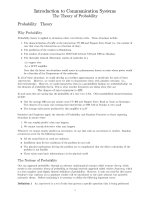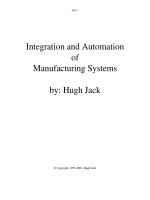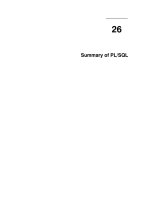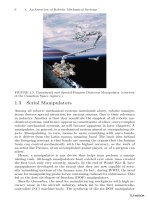Tài liệu Mechanics of Microelectromechanical Systems pdf
Bạn đang xem bản rút gọn của tài liệu. Xem và tải ngay bản đầy đủ của tài liệu tại đây (11.93 MB, 418 trang )
Mechanics of
Microelectro-
mechanical
Systems
This page intentionally left blank
Nicolae Lobontiu
Ephrahim Garcia
Mechanics of
Microelectromechanical
Systems
KLUWER ACADEMIC PUBLISHERS
NEW YORK, BOSTON, DORDRECHT, LONDON, MOSCOW
eBook ISBN: 0-387-23037-8
Print ISBN: 1-4020-8013-1
Print ©2005 Kluwer Academic Publishers
All rights reserved
No part of this eBook may be reproduced or transmitted in any form or by any means, electronic,
mechanical, recording, or otherwise, without written consent from the Publisher
Created in the United States of America
Boston
©2005 Springer Science + Business Media, Inc.
Visit Springer's eBookstore at:
and the Springer Global Website Online at:
To our families
This page intentionally left blank
TABLE OF CONTENTS
Preface
ix
STIFFNESS BASICS
1
1
1
6
14
21
43
58
60
INTRODUCTION
1
2
3
STIFFNESS DEFINITION
DEFORMATIONS, STRAINS AND STRESSES
4
5
6
7
MEMBERS, LOADS AND BOUNDARY CONDITIONS
LOAD-DISPLACEMENT CALCULATION METHODS:
CASTIGLIANO’S THEOREMS
COMPOSITE MEMBERS
PLATES AND SHELLS
Problems
MICROCANTILEVERS, MICROHINGES,
MICROBRIDGES
2
65
65
66
97
103
114
126
131
131
131
170
179
1
2
3
4
5
INTRODUCTION
MICROCANTILEVERS
MICROHINGES
COMPOUND MICROCANTILEVERS
MICROBRIDGES
Problems
3
MICROSUSPENSIONS
1
2
3
INTRODUCTION
MICROSUSPENSIONS FOR LINEAR MOTION
MICROSUSPENSIONS FOR ROTARY MOTION
Problems
4
MICROTRANSDUCTION: ACTUATION AND SENSING
1
2
183
183
184
195
212
223
230
232
238
249
256
257
INTRODUCTION
THERMAL TRANSDUCTION
3
4
5
6
7
8
9
10
ELECTROSTATIC TRANSDUCTION
ELECTROMAGNETIC/MAGNETIC TRANSDUCTION
PIEZOELECTRIC (PZT) TRANSDUCTION
PIEZOMAGNETIC TRANSDUCTION
SHAPE MEMORY ALLOY (SMA) TRANSDUCTION
BIMORPH TRANSDUCTION
MULTIMORPH TRANSDUCTION
OTHER FORMS OF TRANSDUCTION
Problems
1
viii
5
STATIC RESPONSE OF MEMS
263
1
2
3
4
5
6
7
8
INTRODUCTION
263
SINGLE-SPRING MEMS
263
TWO-SPRING MEMS
271
MULTI-SPRING MEMS
285
DISPLACEMENT-AMPLIFICATION MICRODEVICES
286
LARGE DEFORMATIONS
307
BUCKLING
315
COMPOUND STRESSES AND YIELDING
330
Problems
335
6
MICROFABRICATION, MATERIALS, PRECISION AND
SCALING
343
1
INTRODUCTION
2
3
4
5
MICROFABRICATION
MATERIALS
PRECISION ISSUES IN MEMS
SCALING
Problems
Index
343
343
363
365
381
390
395
PREFACE
This book offers a comprehensive coverage to the mechanics of
microelectromechanical systems (MEMS), which are analyzed from a
mechanical engineer’s viewpoint as devices that transform an input form of
energy, such as thermal, electrostatic, electromagnetic or optical, into output
mechanical motion (in the case of actuation) or that can operate with the
reversed functionality (as in sensors) and convert an external stimulus, such as
mechanical motion, into (generally) electric energy. The impetus of this
proposal stems from the perception that such an approach might contribute to
a more solid understanding of the principles governing the mechanics of
MEMS, and would hopefully enhance the efficiency of modeling and
designing reliable and desirably-optimized microsystems. The work
represents an attempt at both extending and deepening the mechanical-based
approach to MEMS in the static domain by providing simple, yet reliable
tools that are applicable to micromechanism design through current
fabrication technologies.
Lumped-parameter stiffness and compliance properties of flexible
components are derived both analytically (as closed-form solutions) and as
simplified (engineering) formulas. Also studied are the principal means of
actuation/sensing and their integration into the overall microsystem. Various
examples of MEMS are studied in order to better illustrate the presentation of
the different modeling principles and algorithms.
Through its objective, approach and scope, this book offers a novel
and systematic insight into the MEMS domain and complements existing
work in the literature addressing part of the material developed herein.
Essentially, this book provides a database of stiffness/compliance models for
various spring-type flexible connectors that transmit the mechanical motion in
MEMS, as well as of the various forces/moments that are involved in
microtransduction. In order to predict their final state, the microsystems are
characterized by formulating, solving and analyzing the static equilibrium
equations, which incorporate spring, actuation and sensing effects.
Chapter 1 gives a succinct, yet comprehensive review of the main
tools enabling stiffness/compliance characterization of MEMS as it lays the
foundation of further developments in this book. Included are basic topics
from mechanics of materials and statics such as load-deformation, stress-
strain or structural members. Presented are the Castigliano’s theorems as basic
tools in stiffness/compliance calculation. Straight and curved line elements
are studied by explicitly formulating their compliance/stiffness characteristics.
Composite micromembers, such as sandwiched, serial, parallel, and hybrid
(serial-parallel) are also treated in detail, as well as thin plates and shells. All
the theoretical apparatus presented in this chapter is illustrated with examples
of MEMS designs.
Chapter 2 is dedicated to characterizing the main flexible components
that are encountered in MEMS and which enable mechanical mobility through
x
their elastic deformation. Studied are flexible members such as microhinges
(several configurations are presented including constant cross-section, circular,
corner-filleted and elliptic configurations), microcantilevers (which can be
either solid or hollow) and microbridges (fixed-fixed mechanical components).
Each compliant member presented in this chapter is defined by either exact or
simplified (engineering) stiffness or compliance equations that are derived by
means of lumped-parameter models. Solved examples and proposed problems
accompany again the basic text.
Chapter 3 derives the stiffnesses of various microsuspensions
(microsprings) that are largely utilized in the MEMS design. Included are
beam-type structures (straight, bent or curved), U-springs, serpentine springs,
sagittal springs, folded beams, and spiral springs (with either small or large
number of turns). All these flexible components are treated in a systematic
manner by offering equations for both the main (active) stiffnesses and the
secondary (parasitic) ones.
Chapter 4 analyzes the micro actuation and sensing techniques
(collectively known as transduction methods) that are currently implemented
in MEMS. Details are presented for microtransduction procedures such as
electrostatic, thermal, magnetic, electromagnetic, piezoelectric, with shape
memory alloys (SMA), bimorph- and multimorph-based. Examples are
provided for each type of actuation as they relate to particular types of MEMS.
Chapter 5 is a blend of all the material comprised in the book thus far,
as it attempts to combine elements of transduction (actuation/sensing) with
flexible connectors in examples of real-life microdevices that are studied in
the static domain. Concrete MEMS examples are analyzed from the
standpoint of their structure and motion traits. Single-spring and multiple-
spring micromechanisms are addressed, together with displacement-
amplification microdevices and large-displacement MEMS components. The
important aspects of buckling, postbuckling (evaluation of large
displacements following buckling), compound stresses and yield criteria are
also discussed in detail. Fully-solved examples and problems add to this
chapter’s material.
The final chapter, Chapter 6, includes a presentation of the main
microfabrication procedures that are currently being used to produce the
microdevices presented in this book. MEMS materials are also mentioned
together with their mechanical properties. Precision issues in MEMS design
and fabrication, which include material properties variability,
microfabrication limitations in producing ideal geometric shapes, as well as
simplifying assumptions in modeling, are addressed comprehensively. The
chapter concludes with aspects regarding scaling laws that apply to MEMS
and their impact on modeling and design.
This book is mainly intended to be a textbook for upper-
undergraduate/graduate level students. The numerous solved examples
together with the proposed problems are hoped to be useful for both the
student and the instructor. These applications supplement the material which
xi
is offered in this book, and which attempts to be self-contained such that
extended reference to other sources be not an absolute pre-requisite. It is also
hoped that the book will be of interest to a larger segment of readers involved
with MEMS development at different levels of background and
proficiency/skills. The researcher with a non-mechanical background should
find topics in this book that could enrich her/his customary modeling/design
arsenal, while the professional of mechanical formation would hopefully
encounter familiar principles that are applied to microsystem modeling and
design.
Although considerable effort has been spent to ensure that all the
mathematical models and corresponding numerical results are correct, this
book is probably not error-free. In this respect, any suggestion would
gratefully be acknowledged and considered.
The authors would like to thank Dr. Yoonsu Nam of Kangwon
National University, Korea, for his design help with the microdevices that are
illustrated in this book, as well as to Mr. Timothy Reissman of Cornell
University for proof-reading part of the manuscript and for taking the pictures
of the prototype microdevices that have been included in this book.
Ithaca, New York
June 2004
This page intentionally left blank
Chapter 1
STIFFNESS BASICS
1.
INTRODUCTION
Stiffness is a fundamental qualifier of elastically-deformable mechanical
microcomponents and micromechanisms whose static, modal or dynamic
response need to be evaluated. This chapter gives a brief introduction to the
stiffness of microeletromechanical structural components by outlining the
corresponding linear, small-deformation theory, as well as by studying
several concrete examples. The fundamental notions of elastic deformation,
strain, stress and strain energy, which are all related to stiffness, are briefly
outlined. Energy methods are further presented, specifically the Castigliano’s
theorems, which are utilized herein to derive stiffness or compliance
equations.
A six degree-of-freedom lumped-parameter stiffness model is proposed
for the constant cross-section fixed-free straight members that are sensitive to
bending, axial and torsion loading. A similar model is developed for curved
members, both thick and thin, by explicitly deriving the compliance
equations. Composite beams, either sandwiched or in serial/parallel
configurations, are also presented in terms of their stiffnesses. Later, the
stiffness of thin plates and membranes is approached and equations are
formulated for circular and rectangular members. Problems that are proposed
to be solved conclude this chapter.
2.
STIFFNESS DEFINITION
MEMS mainly move by elastic deformation of their flexible components.
One way of characterizing the static response of elastic members is by
defining their relevant stiffnesses. The simple example of a linear spring is
shown in Fig. 1.1, where a force is applied by slowly increasing its
magnitude from zero to a final value over a period of time such that the
force is in static equilibrium with the spring force at any moment in time.
The force necessary to extend the spring by the quantity is calculated
as:
2
Chapter 1
where is the spring’s linear stiffness, which depends on the material and
geometrical properties of the spring. This simple linear-spring model can be
used to evaluate axial deformations and forced-produced beam deflections of
mechanical microcomponents. For materials with linear elastic behavior and
in the small-deformation range, the stiffness is constant. Chapter 5 will
introduce the large-deformation theory which involves non-linear
relationships between load and the corresponding deformation. Another way
of expressing the load-deformation relationship for the spring in Fig. 1.1 is
by reversing the causality of the problem, and relating the deformation to the
force as:
where is the spring’s linear compliance, and is the inverse of the stiffness,
as can be seen by comparing Eqs. (1.1) and (1.2).
Figure 1.1
Load and deformation for a linear spring
Similar relationships do also apply for rotary (or torsion) springs, as the one
sketched in Fig. 1.2 (a). In this case, a torque is applied to a central shaft.
The applied torque has to overcome the torsion spring elastic resistance, and
the relationship between the torque and the shaft’s angular deflection can be
written as:
The compliance-based equation is of the form:
1. Stiffness basics
3
Figure 1.2 Rotary/spiral spring: (a) Load; (b) Deformation
Again, Eqs. (1.3) and (1.4) show that the rotary compliance is the inverse of
the rotary stiffness. The rotary spring is the model for torsional bar
deformations and moment-produced bending slopes (rotations) of beams.
Both situations presented here, the linear spring under axial load and the
rotary spring under a torque, define the stiffness as being the inverse to the
corresponding compliance. There is however the case of a beam in bending
where a force that is applied at the free end of a fixed-free beam for instance
produces both a linear deformation (the deflection) and a rotary one (the
slope), as indicated in Fig. 1.3 (a).
Figure 1.3 Load and deformations in a beam under the action of a: (a) force; (b) moment
In this case, the stiffness-based equation is:
The stiffness connects the force to its direct effect, the deflection about the
force’s direction (the subscript l indicates its linear/translatory character).
The other stiffness, which is called cross-stiffness (indicated by the
4
Chapter 1
subscript c
),
relates a cause (the force) to an effect (the slope/rotation) that is
not a direct result of the cause, in the sense discussed thus far. A similar
causal relationship is produced when applying a moment at the free end of
the cantilever, as sketched in Fig. 1.3 (b). The moment generates a
slope/rotation, as well as a deflection at the beam’s tip, and the following
equation can be formulated:
Formally, Eqs. (1.5) and (1.6) can be written in the form:
where the matrix connecting the load vector on the left hand side to the
deformation vector in the right hand side is called bending-related stiffness
matrix.
Elastic systems where load and deformation are linearly proportional are
called linear, and a feature of linear systems is exemplified in Eq. (1.5),
which shows that part of the force is spent to produce the deflection and
the other part generates the rotation (slope) Equation (1.6) illustrates the
same feature. The cross-compliance connects a moment to a deflection,
whereas (the rotary stiffness, signaled by the subscript r) relates two
causally-consistent amounts: the moment to the slope/rotation. The
stiffnesses and can be called direct stiffnesses, to indicate a force-
deflection or moment-rotation relationship. Equations that are similar to Eqs.
(1.5) and (1.6) can be written in terms of compliances, namely:
and
where the significance of compliances is highlighted by the subscripts which
have already been introduced when discussing the corresponding stiffnesses.
Equations (1.8) and (1.9) can be collected into the matrix form:
1.
Stiffness basics
5
where the compliance matrix links the deformations to the loads. Equations
(1.8) and (1.9) indicate that the end deflection can be produced by linearly
superimposing (adding) the separate effects of and As shown later on,
Equations (1.5) and (1.6), as well as Eqs. (1.8) and (1.9) indicate that three
different stiffnesses or compliances, namely: two direct (linear and rotary)
and one crossed, define the elastic response at the free end of a cantilever.
More details on the spring characterization of fixed-free microcantilevers that
are subject to forces and moments producing bending will be provided in this
chapter, as well as in Chapter 2, by defining the associated stiffnesses or
compliances for various geometric configurations
Example 1.1
Knowing that for the constant
cross-section cantilever loaded as shown in Fig. 1.4, demonstrate that
where [K] is the symmetric stiffness matrix defined by:
Figure 1.4 Cantilever with tip force and moment
Solution:
Equation (1.10) can be written in the generic form:
When left-multiplying Eq. (1.11) by the following equation is obtained:
Equation (1.7) can also be written in the compact form:
By comparing Eqs. (1.12) and (1.13) it follows that:
The compliance matrix:
6
Chapter 1
is now inverted and the resulting stiffness matrix is:
An explanation of the minus sign in front of the cross-stiffness in Eq. (1.16)
will be provided in Example 1.15 of this chapter.
The direct stiffnesses can physically be represented by a linear spring (in
the case of a force-deflection relationship) – as pictured in Fig 1.1, or a rotary
one (for a moment-rotation relationship) – as indicated in Fig. 1.2. These two
cases are sketched for a cantilever beam in Figs. 1.5 (a) and (b) by the two
springs, one linear of stiffness and one rotary of stiffness The cross-
stiffness is represented in Fig. 1.5 (c), which attempts to give a physical,
spring-based representation of the situation where the moment creates a
linear deformation (the deflection by means of the eccentric disk which
rotates around a fixed shaft and thus moves vertically the tip of the beam.
Figure 1.5
Spring-based representation of the bending stiffnesses:
(a) direct linear stiffness;
(b) direct rotary stiffness; (c) cross-stiffness
3.
DEFORMATIONS, STRAINS AND STRESSES
The stiffness of a deformable MEMS component can generally be found
by prior knowledge of the corresponding deformations, strains and/or
stresses. The deformations of elastic bodies under load can be linear
(extension or compression) or angular, and Fig. 1.6 contains the sketches that
illustrate these two situations. When a constant pressure is applied normally
1. Stiffness basics
7
on the right face of the element shown in Fig. 1.6 (a), while the opposite face
is fixed, the elastic body will deform linearly by a quantity such that the
final length about the direction of deformation will be The ratio of
the change in length to the initial length is the linear strain:
If an elementary area dA is isolated from the face that has translated, one can
define the normal stress on that surface as the ratio:
Figure 1.6
Element stresses: (a) normal; (b) shearing
where is the elementary force acting perpendicularly on dA. For small
deformations and elastic materials, the stress-strain relationship is linear, and
in the case of Fig. 1.6 (a) the normal stress and strain are connected by means
of Hooke’s law:
where E is Young’s modulus, a constant that depends on the material under
investigation.
When the distributed load acts on the upper face of the volume element
and is contained in that face, as sketched in Fig. 1.6 (b), while the opposite
face is fixed, the upper face will shear (rotate) with respect to the fixed
surface. The relevant deformation here is angular, and the change in angle
is defined as the shear strain in the form:
8
Chapter 1
Similarly to the normal strain, the shear strain is defined as:
A linear relationship also exists between shear stress and strain, namely:
where G is the shear modulus and, for a given material, is a constant amount.
Young’s modulus and the shear modulus are connected by means of the
equation:
where is Poisson’s ratio.
For a three-dimensional elastic body that is subject to external loading
the state of strain and stress is generally three-dimensional. Figure 1.7 shows
an elastic body that is subject to the external loading system generically
represented by the forces through In the case of static equilibrium, with
thermal effects neglected, an elementary volume can be isolated, which is
also in equilibrium under the action of the stresses that act on each of its
eight different faces.
Figure 1.7 Stresses on an element removed from an elastic body in static equilibrium
As Fig. 1.7 indicates, there are 9 stresses acting on the element’s faces, but
the following equalities, which connect the stresses, do apply:
1. Stiffness basics
9
Because of the three Eqs. (1.24), which enforce the rotation equilibrium, only
6 stresses are independent. The equilibrium (or Navier’s) equations are:
where X, Y and Z are body force components acting at the center of the
isolated element.
Six strains correspond to the six stress components, as expressed by the
generalized Hooke’s law:
The strain-displacement (or Cauchy’s) equations relate the strains to the
displacements as:
It should be noted that for normal strains (and stresses), the subscript
indicates the axis the stress is parallel to, whereas for shear strains (and
stresses), the first subscript indicates the axis which is parallel to the strain,
10
Chapter 1
while the second one denotes the axis which is perpendicular to the plane of
the respective strain.
By combining Eqs. (1.25), (1.26) and (1.27), the following equations are
obtained, which are known as Lamé’s equations:
Equations (1.28) contain as unknowns only the three displacements and
In Eqs. (1.28), is Lamé’s constant, which is defined as:
In order for the equation system (1.28) to yield valid solutions, it is
necessary that the compatibility (or Saint Venant’s
)
equations be complied
with:
Equations (1.24) through (1.30) are the core mathematical model of the
theory of elasticity. More details on this subject can be found in advanced
mechanics of materials textbooks, such as the works of Boresi, Schmidt and
Sidebottom [1], Ugural and Fenster [2] or Cook and Young [3].
Many MEMS components and devices are built as thin structures, and
therefore the corresponding stresses and strains are defined with respect to a
1. Stiffness basics
11
plane. Two particular cases of the general state of deformations described
above are the state of plane stress and the state of plane strain. In a state of
plane stress, as the name suggests, the stresses are located in a plane (such as
the middle plane that is parallel to the xy plane in Fig. 1.7). The following
stresses are zero:
Figure 1.8 Plane state of stress/strain
Thin plates, thin bars and thin beams that are acted upon by forces in their
plane, are examples of MEMS components that are in a plane state of stress.
For thicker components, the cross-sections of shafts in torsion are also in a
stat
e
of plane stress. In a state of plane strain, the stress perpendicular to the
plane of interest does not vanish, but all other stresses in Eqs. (1.31)
are zero. Microbeams that are acted upon by forces perpendicular to the
larger cross-sectional dimension are in a state of plane strain for instance.
Figur
e
1.8 illustrates both the state of plane stress and the state of plane strain.
Example 1.2
A thin microcantilever, for which t << w, can be subject to a force as
shown in Fig. 1.9 (a) or to a force as pictured in Fig. 1.9 (b). Decide on the
state of stress/strain that is setup in each of the two cases.
Solution:
The loading and geometry of Fig. 1.9 (a) show that the stresses and
strains will be planar because of the thin condition of the microcantilever (t
<< w). However, because the load is perpendicular to the plane xy, the stress
about the z-direction does not vanish, and therefore, according to the
definition introduced previously, the microcantilever is in a state of plane
strain. In the case pictured in Fig. 1.9 (b), the force is located in the xy
12
Chapter 1
plane of the thin microcantilever, and there is no stress acting about the z-
direction. As a consequence, and according to its definition, a state of plane
stress is setup in the microcantilever under this particular load.
Figure 1.9 Thin microbeams under the action of a tip force: (a) perpendicular to the plane;
(b) in-the-plane
Example 1.3
A thin-film microbar, having the configuration and dimensions of
Fig. 1.10 is subject to a state of extensional residual stresses (this condition
will be detailed in Chapter 6) after microfabrication. The state of residual
stress will generate an axial deformation of the bar, which can be monitored
experimentally, as sketched in Fig. 1.10. By using the theory of elasticity
equations, determine the residual stress in the film. Known are:
and E=120GPa.
Figure 1.10 Displacement sensing for residual stress measurement in a microbar
Solution:
This particular state of stress, where only the normal stresses about the x-
direction are non-zero, is called state of uniaxial stresses. Hooke’s law Eqs.
(1.26) simplify to the following form:









